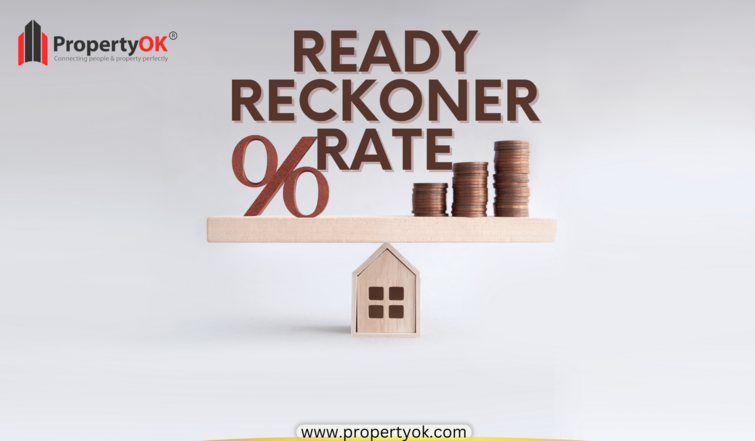To avoid paying taxes, buyers frequently work with sellers to have the property registered at the circular rate while the buyer is forced to pay at the conventional market rate. This lowers capital gains tax for sellers while increasing stamp duty for buyers.
In addition, all State governments publish region-specific property rates each year, known as the Ready Reckoner Rate, to ensure an accurate real estate properties (RRR) valuation. States, cities, and towns all have different circle rates, often known as RRRs.
What is the Ready Reckoner rate?
So, what is the ready reckoner rate? The standard value of immovable property is assessed and governed by the state government in which it is situated and is known as the Ready Reckoner Rate (RRR). Residential, commercial, and land/plot property are all included under the term “immovable property” in this context.
The Ready Reckoner Rate, often known as the Circle Rate, is the state government’s established standard valuation for real estate assets such as land, buildings used for commerce, and homes. New Ready Reckoner Rates depending on various regions of the states are published by state governments every year. The rates, however, mostly differ between states, cities, or locales.
The RRR in various places is set based on several variables. No property transaction is permitted below this established standard set for a locality. As a result, we may state that the Ready Reckoner Rate is the base rate at which the government assesses registration fees and stamp duties for any real estate transaction. The ready reckoner rate or the transaction’s actual value, whichever is larger, is used to determine the stamp duty.
Stamp duty is charged following Schedule I of the Maharashtra Stamp Act on the type of instrument and amount mentioned in it, whichever is higher under the article, and stamp duty is collected on the document by the Collector of Stamps and Registration Department. Annual Statement Rates (ASR), also known as Ready Reckoner, are the immovable property fare rates based on which the property’s market value is calculated.
How is the Ready Reckoner rate calculated?
Now talking about how to calculate the ready reckoner rate? There are different ways by a different state. But this is a general one.
- Determine the built-up area of the property by factoring in things like floors, facilities, the age of the structure, the area, and more (depending on the type of property, such as a flat or commercial unit). If two built-up area numbers are supplied, the original value and the one with 1.2 times the carpet area consider the higher value.
- Then, use the formula below to calculate the property’s worth at the ready reckoner rate after deciding on the property’s location.
If it is flat, use the following formula: covered parking spaces multiplied by 25% ready reckoner rate per unit area for that property.
Property built-up area multiplied by the ready reckoner pricing for apartments in rupees per square meter.
Parking spaces that are vacant times a factor of 40 percent of the nearby developed land’s ready reckoner value.
The Western Expressway, the harbor line, the marine drive, and other significant railway and road corridors are only a few factors that have led to Mumbai, India’s financial hub, being divided into 19 zones and 221 subzones.
Similarly, a premium is added to the ready reckoner rate for high-rise residential floors by the governments of Maharashtra and Mumbai. The premium, however, remains the same as it was in Pune.
To compute the assessed value for stamp duty and registration fees, the valuation for stilts, closed parking lots, and open parking lots is the same as in Pune.
Mumbai’s stamp duty rates fixed by the department of registration and stamp Maharashtra:
- Male – 5%.
- Female – 4%.
- Male and Female co-owners- 5%.
In June 2021, the Assessor and Collector Department submitted a proposal to the BMC’s standing committee to raise the property tax by 14% based on the most recent ready reckoner rates. However, the increase will not impact buildings less than 500 square feet. If the standing committee approves, the revised rules will enter into force on April 1 and remain in effect until March 31, 2025.
Read more: How to register property in Thane.
According to Section 43CA of the Income Tax Act, selling a property at a price that is at least 10% below the Stamp duty ready reckoner, also referred to as the circle rate, may result in a 35 percent penalty of the difference between the original price and the revised price. It will also apply to the property’s buyer.
The real estate market declined following the COVID-19 pandemic in 2020 and other occurrences like demonetization in the past, which notably aided in the surge in unsold inventory. Because there was no longer room to cut prices, real estate developers struggled to preserve margins.
The Confederation of Real Estate Developers’ Associations of India (CREDAI) and the National Real Estate Development Council (NAREDCO) suggested necessary revisions to the income tax legislation and changes to ready reckoner rates for 2020 to keep them in line with current market pricing. For the fundamental requirements of RRR, various websites have been built. These were created to provide basic information.
Trending Properties
Importance of ready Reckoner rate:
The RRR serves as a threshold beyond which no real estate transactions in a region are permitted. Generally, it is the lowest price a buyer must pay for a property and the lowest amount on which the government assesses stamp duty and registration fees.
A decent way to estimate the price a potential house buyer will have to pay is to look at the RR rate of properties in that region. Property values in an area typically rise when the RR rate is anticipated to rise, and market rates of properties are typically higher.
Impact of Ready Reckoner rate on real estate transactions:
Although RRR sets the minimum selling price of the property, neither the maximum property price nor the market rate is restricted. The market rate is, by definition, the ultimate amount a buyer pays for a property considering the facilities offered and prior real estate transactions in the area. Most properties in India are sold at market rates, which results in higher prices for buyers because these rates are often greater than RRR.
The market price, typically much greater than RRR, is what a client agrees to pay for a certain property. The buyer pays more out of pocket because market rates are greater.
The issue now is that people show prices lower than the true value to keep it near the RRR to save money on taxes and payment of stamp duty. With this procedure, customers must pay the bare minimum in registration fees and stamp duty; the remaining amount is paid in liquid funds. As a result, the volume of black money in the market and the state’s revenue losses are greatly increased.
However, it has been shown that quarterly or biennial revisions to the circular rates guarantee parity between those rates and market rates. Therefore, the circle rates need occasionally be revised by the State governments.
A higher circle rate would secure larger revenues from stamp duties and registration fees for the State governments, as well as aid in preventing the circulation of black money in the real estate industry.
Effect of Ready reckoner rate on stamp duty and registration charges:
The lowest price at which a property must be registered in the event of a transfer is the Ready Reckoner rate, also called the circle rate. To lessen disputes over the amount of stamp duty and prohibit the avoidance of stamp tax through undervaluing agreements, area-based Stamp duty-ready reckoner for properties is published by all state governments once a year. Maharashtra, for instance, publishes the ready reckoner rate for Mumbai.
Even if Ready Reckoner rates set the lowest sum at which properties can be sold in an area, there is no upper limit above which a property cannot be sold. The Ready Reckoner and market rates thus differ greatly. Most real estate transactions in India are based on the average neighborhood price.
The stamp duty and registration fees that the home buyer must pay are calculated based on this market rate. Therefore, the government loses money when the RR rate differs significantly from the market rate. In rare instances where the RR rate is higher, the stamp duty and registration charges will be calculated using the online ready reckoner rate.
Conclusion:
Market rates for homes are frequently higher, and local property values increase when an increase in the RR rate is anticipated. Therefore, it is favorable for buyers to purchase real estate in an area where the gap between the ready reckoner rate and the market rate is relatively less, particularly if a home loan funds the acquisition.
Click Here to read and clarify your doubts related to the real estate sector.
Frequently Asked Questions:
1. What is the Ready Reckoner rate in Thane?
In Thane, the Ready Reckoner Rate ranges from Rs. 2180 to Rs. 35830 per sq. mt. The rates have increased by 9.48 percent in Thane.
2. Who sets Ready Reckoner rates?
The government determines the ready reckoner rate, which is used as the basis for real estate transactions.
3. How to check Ready Reckoner rates?
You may view the Maharashtra circular rates on the Department of Registration and Stamps website. Additionally, you can receive a current ready reckoner rate list from the authorized staff at the Sub-office Registrars in your city.






 Thank You
Thank You